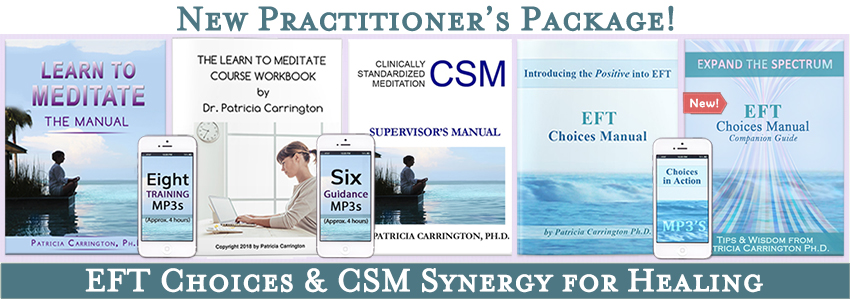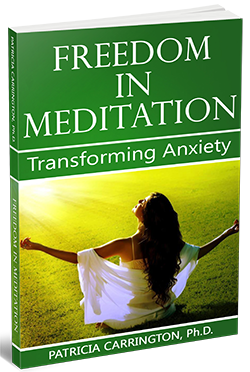Dr. Patricia Carrington’s award winning meditation technique CSM (Clinically Standardized Meditation) is a clinically sensitive meditation method used by numerous medical institutions, organizations, and individuals worldwide. For information click here.
Meditating to Increase Creativity
Patricia Carrington, Ph.D.
Author of “The Book of Meditation”
Some people have reported striking changes in the nature of their creative work which they themselves have attributed directly to meditation. Probably the most impressive instance of this is a former patient. Tony found psychotherapy an exceedingly painful experience. He had been to several therapists before coming to me and during the time that he and I worked together, this sensitive, gifted young man found it so anxiety provoking to talk about his problems that he would lapse into silence a good portion of the time.
Since Tony showed an interest in drawing and painting, I decided to use art therapy in his treatment. When crayons and a large pad of paper were made available, he readily ‘drew his feelings’ on paper and we were able to discuss them. Sometimes he would alter his drawings to reflect newer, healthier attitudes toward himself. His artwork was not outstanding, however. He was a rather awkward beginner and I viewed his drawing simply as a therapeutic maneuver.
Tony then left for another city. While he had improved his outlook somewhat, he was still far from comfortable in therapy and had yet to bring under control a lifelong tendency toward intermittent depressions. Some months after moving, he phoned me to request that I recommend a new therapist in his vicinity. Knowing his past difficulty in opening up in therapy, I suggested to him that he first learn Transcendental Meditation (TM) near where he lived, practice it for three months, and then re-contact me at the end of that time.
Tony followed through on this suggestion and as soon as he learned meditation he found it had a profound effect upon him. His meditation sessions were, from the first, deeply compelling experiences. More impressive, however, were the effects they had on his life. His troublesome depressions came under control and remained stabilized thereafter. He became a regular and enthusiastic meditator, almost never missing his two sessions a day.
At the end of three months of meditating, Tony felt ready to re-enter therapy, so I referred him to a therapist in his new vicinity. Because of the changes brought about by meditation, he had now acquired a different outlook on psychotherapy. He no longer felt that therapists were ‘all-powerful’; and in searching for his new therapist, he found himself sensing his own rights in the situation. When he started his new course of therapy he was able to talk freely and productively and use the experience to great advantage. Since the anxiety which had formerly all but paralyzed him in his treatment sessions was greatly lessened as a result of meditation, during this new course of treatment he made excellent progress.
Particularly surprising was the change in the quality of his creative work. Meditation seemed almost immediately to release a wellspring of creativity within him. Soon after learning this technique, he was completing four to five paintings a week, while at the same time holding down a full-time job as a cabinetmaker. Although he sometimes ran into fallow periods, for the most part he was astonishingly productive. When I had the opportunity to view a showing of his paintings a year after he had stopped working with me, I was startled to see the difference in his work. His painting style had changed from an awkward, constricted, amateurish one to a powerful, artistic expression. Here was an artist with integrity, strength and surprising technical mastery. His fantasy figures, somewhat reminiscent of Chagall’s, were at the same time his own unique statements. Tony has, to date, exhibited his paintings and his figured pottery (which is equally original) in a number of galleries. He remains absorbed in his artistic work and continues to meditate with absolute regularity. In this instance, I witnessed a flowering of a vital talent which had not been evident before the artist began meditating. Obviously, meditation did not create his talent, but it seems to have released it at a strategic point in his life.
Verified anecdotes of this sort are to me more impressive than the few statistical studies presently available which deal with increased creativity as a result of practicing meditation. Means for measuring creativity on a wide scale are far from adequate at this point. We can select a few components of the creative process and identify them, but the elusive quality that makes the true artist can still only be identified by viewing his artistic work.
One study measuring changes in ‘creativity’ with meditation is worth mentioning, however. Researchers at California State University compared a group of people who had been practicing TM for several months with a group about to learn the method. Both were given a test for creative thinking.1 The people who were already meditating did better on this test than those who were about to learn meditation and, as in the Hines study, the meditators showed greater ideational fluency. They also showed more flexibility and more originality in their thinking than did the non-meditators. This study, of course, has some of the flaws seen in all meditator versus non-meditator comparisons. We do not know whether these meditators might have scored better on creativity tests even before they learned to meditate.
1. M. J. MacCullum, ‘Transcendental Meditation and Creativity’, in Research on the Transcendental Meditation Program: Collected Papers, ed. D. W. Orme-Johnson and J. T. Farrow, (Livingston Manor, NY: Maharishi European Research University Press, 1978) vol. I, pp. 410–14.






